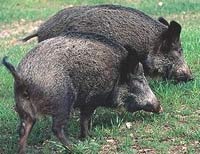Wild hog population rises in Texas because of wet summer
Texas ranchers and farmers fighting the largest population of feral hogs in the United States could soon be trying to ward off twice as many of the tusked, field-shredding animals.

Wildlife officials fear the ample water and vegetation brought by record-setting rains in Texas this year could double the state estimate of 2 million hogs. The animals reproduce prolifically even under normal conditions, with sows annually having up to two litters of four to eight piglets.
"We are seeing an absolute explosion," said Kirby Brown, executive vice president of the Texas Wildlife Association. "They are on a roll right now."
Feral hogs are the most prolific large, wild mammal in North America. Descendants of domestic hogs, they are found in nearly all of Texas' 254 counties and in about 38 other states. Texas has roughly half the nation's population.
The hogs, which can weigh 400 pounds - 180 kilograms - or more and have been known to act aggressively toward people when cornered, cause an estimated $52 million (EUR36 million) in damage annually to crops and property, state officials said.
Rancher Jim McAdams said a dozen hogs can mangle five acres, or two hectares, of pasture in one visit to his property near the city of College Station, leaving behind torn ground that ruins equipment.
"They just are a big nuisance," he said. "And despite all our best efforts, the population continues to grow."
The state has been looking for ways to get rid of the animals for years, said Brian Cummins, an extension agent in Van Zandt County in northeast Texas.
In 2005, lawmakers approved $500,000 in grants to fund the Feral Hog Damage Abatement Program, which included a pilot program to assess crop damage, evaluate control efforts and measure economic impact. The grant also allowed for research to develop pheromone and odor combinations that can be used to attract feral hogs to traps, as well as the study of reproductive control methods.
Texas had the wettest January through July ever recorded, with a statewide average of 27.11 inches (68 centimeters) - nearly 11 inches (28 centimeters) above the norm. The wet weather brought growth of vegetation and underbrush, which piglets use for cover from hunters.
"The sows are super healthy," said Cody Weiser, editor of Wild Boar USA magazine. "With the amount of nutrition available all the pigs from this past spring have had plenty to eat. It's going to make for a very high survival rate."
The hogs dig up cropland, pastures and landscapes, and compete for food with wildlife such as white-tailed deer.
Though ranchers and farmers consider them a nuisance, hunters seek them out. Hunting season is year-round and there is no limit. "Take all you want and leave the rest," Cummins said.
Trapping the feral hogs in large metal cages is the best way to control them, but there will be more juvenile hogs this year, which can more easily worm their way out of the traps.
Also, hogs will probably be turning up their snouts at shelled corn that's used to lure them into traps because better food will be falling from the trees.
"It looks like we're going to have a pretty good acorn crop, and Texas is full of oaks, and the hogs love acorns," Cummins said.
Subscribe to Pravda.Ru Telegram channel, Facebook, RSS!





